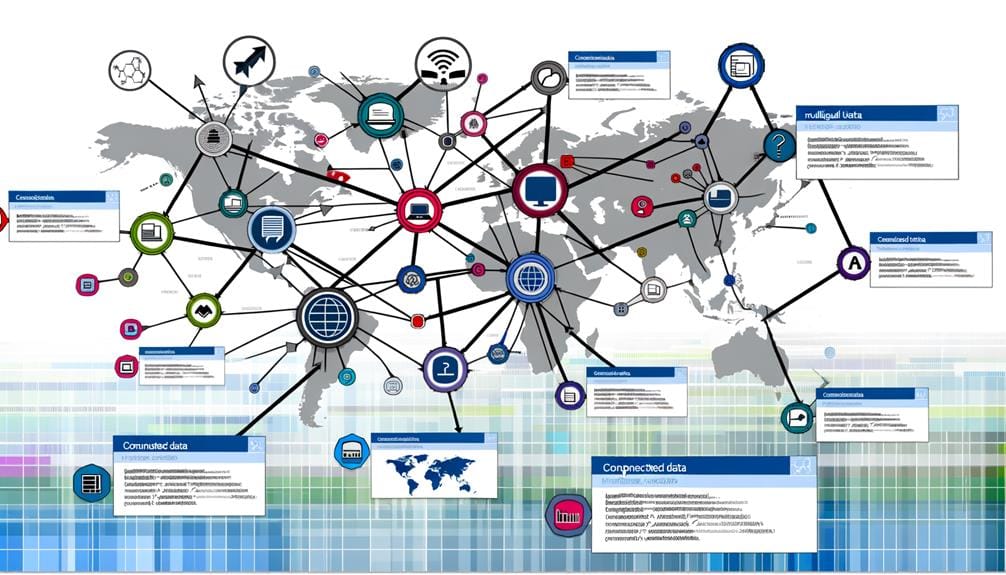To master semantic multilingual SEO, optimize your content for multiple languages while leveraging advanced strategies. Use tools like Google's RankBrain and BERT to understand user intents and context. Implement structured data and hreflang tags to improve indexing and relevance. Conduct thorough keyword research tailored to each language and region, and use long-tail keywords for better visibility. Enhance user experience with mobile responsiveness, localized content, and fast loading times. Focus on building quality backlinks and strategically interlinking content within topic clusters. Monitor performance with tools like Google Analytics to refine your approach. Explore further to transform your SEO strategy decisively.
Key Takeaways
- Integrate structured data markup and hreflang tags for each language to enhance search engine understanding and targeting.
- Conduct thorough multilingual keyword research focusing on long-tail keywords and local search trends for better visibility.
- Create language-specific sitemaps and optimize meta tags and content for each language to improve indexing and relevance.
- Develop high-quality, language-specific backlinks from authoritative websites to boost search engine rankings.
- Ensure consistent and accurate translations across all languages to maintain user experience and SEO performance.
Understanding Semantic SEO
Understanding Semantic SEO means mastering how search engines interpret the meaning and context behind user queries. By focusing on semantic SEO, you're optimizing content to align with how search engines understand the intricacies of language, user intent, and entity relationships.
Google's advancements, such as the Knowledge Graph, Hummingbird, RankBrain, and BERT, have revolutionized the way algorithms process information. These tools leverage natural language processing (NLP) and artificial intelligence (AI) to understand content on a deeper level.
To excel in search engine optimization, you need to consider the meaning and context of your keywords, not just their frequency. Instead of targeting isolated keywords, integrate topic clusters that provide comprehensive insights into a subject. This approach helps search engines understand the broader context and interconnections between entities like individuals, places, organizations, and concepts.
Entity relationships play a crucial role in how search engines interpret content. By structuring your data to reflect clear relationships, you enhance the search engine's ability to deliver relevant results.
As AI and NLP technologies continue to evolve, aligning your strategies with these advancements will ensure your content remains competitive and accessible.
Importance of Multilingual SEO

Embracing multilingual SEO is crucial for tapping into global markets, as a significant 75% of internet users prefer content in their native language. By addressing language preferences, you can effectively engage global audiences and expand your reach into diverse markets.
Implementing multilingual SEO isn't just about communication; it's a strategic move that can lead to a revenue increase of up to 40%. This growth is driven by improved online visibility and a higher click-through rate (47% more) for multilingual websites compared to their single-language counterparts.
Considering that over 60% of Google searches are conducted in languages other than English, focusing on multilingual SEO is essential. It ensures that your content appears in more search results, broadening your potential customer base.
Conducting Keyword Research
To maximize the benefits of multilingual SEO, start by conducting thorough keyword research tailored to each target language and region. Use tools like SEMrush, Ahrefs, and Google Keyword Planner to identify high-volume keywords. This ensures you're capturing the most relevant search queries in each language.
Consider cultural nuances and regional variations to avoid missteps that could alienate your audience. For instance, a popular keyword in Spain mightn't resonate in Mexico. Understanding these subtleties enhances your multilingual SEO strategy.
Here's a concise approach to effective keyword research:
- Identify Long-Tail Keywords: These are less competitive and more specific, providing better visibility in local searches.
- Analyze Search Trends: Keep track of what's trending in each region to stay relevant. This can dramatically boost your organic traffic.
- Study Competitor Keywords: Look at what your competitors are ranking for in different languages. This can offer insights into gaps and opportunities in your strategy.
Don't forget to incorporate semantic keywords to enrich your content and improve search relevance. By strategically analyzing search trends and competitor keywords, you're not just optimizing for search engines but also creating content that resonates with diverse audiences.
Topic Clustering Strategy

To effectively implement a topic clustering strategy, start by using keyword research to identify core topics and subtopics.
Next, interlink related content to create a cohesive structure that enhances SEO authority and user experience.
This approach boosts search rankings and drives more organic traffic to your site.
Keyword Research Essentials
Effective keyword research for a topic clustering strategy starts with identifying primary topics and related subtopics to cover every aspect of your subject comprehensively. This approach is essential for creating a robust content structure that enhances semantic SEO, improving your search rankings and organic traffic.
To begin, follow these steps:
- Identify Primary Topics: Determine the core subjects that are most relevant to your audience and business. These primary topics form the foundation of your content strategy.
- Research Related Subtopics: Use keyword research tools to find subtopics that complement your primary topics. These subtopics should address specific queries and interests within the broader subject.
- Analyze Competitor Content: Examine top-ranking content for your primary topics and related subtopics. Identify gaps and opportunities to create more comprehensive content.
Content Interlinking Tips
Frequently, interlinking related content within your topic clusters significantly boosts both SEO performance and user engagement. An effective SEO strategy hinges on creating a logical content structure that search engines understand. By employing internal linking within topic clusters, you enhance the semantic SEO and establish clear relationships between different pieces of related content.
Implementing a topic clustering strategy not only improves user experience but also increases the time users spend on your site. This method helps search engines understand your content better, thereby boosting your website's authority and search rankings. Your primary goal should be to create a cohesive content structure that's easy for both users and search engines to navigate.
Here's a breakdown of key benefits:
| Benefit | Description | Impact |
|---|---|---|
| SEO Strategy | Enhances search engines' understanding | Higher search rankings |
| User Experience | Improved navigation and content discovery | Increased time on site |
| Website Authority | Establishes a clear relationship among content | Boosts overall site credibility |
| Semantic SEO | Logical content structure | Better indexing and ranking |
Long-Form Content Creation

Creating long-form content over 1,200 words can significantly boost your search engine rankings and organic traffic. This strategy allows you to provide an in-depth analysis and comprehensive coverage of your topic, making it more valuable to your audience. By incorporating semantic keywords, you'll enhance search engine understanding and improve user engagement.
Long-form content lets you delve into various subtopics, addressing multiple facets of a subject to cater to diverse user queries. Structuring your content with clear headings, subheadings, and sections ensures readers can easily navigate and grasp the information presented.
Here's how you can optimize your long-form content:
- Use Semantic Keywords: Integrate related terms naturally to help search engines understand the context and relevance of your content.
- Organize with Clear Headings: Break down your content into manageable sections with descriptive headings to improve readability and retention.
- Include In-Depth Analysis: Offer comprehensive coverage of the topic, providing detailed insights and addressing various angles to engage your readers thoroughly.
Structured Data Implementation

Implementing structured data on your web pages is a strategic move to enhance search engine understanding and boost your SEO performance. By using schema markup, you provide search engines with the context and meaning needed to better interpret your content. This, in turn, can lead to improved indexing and display of content, especially crucial for multilingual SEO.
Structured data is the backbone of many enhanced search results, such as rich snippets and knowledge panels. These SERP features can significantly elevate your content's visibility and click-through rates. When search engines comprehend your content more accurately, they're more likely to present it in an engaging manner, making it more appealing to users.
For multilingual SEO, structured data ensures that your content is correctly indexed and displayed in various languages. This means search engines can efficiently understand and categorize your content, regardless of the language, leading to more accurate and relevant search results.
Incorporating structured data into your SEO strategy not only enhances content understanding but also maximizes your presence on search engine results pages. By prioritizing schema markup, you're setting a solid foundation for better search engine performance and user engagement.
Enhancing User Experience

Enhancing user experience through multilingual SEO ensures your audience can access content in their preferred language, boosting engagement and satisfaction. By leveraging semantic SEO techniques, you can cater to a global audience, making your site more accessible and retaining users more effectively.
To optimize user experience through multilingual SEO, consider these strategic steps:
- Implement Hreflang Tags: Correctly applied hreflang tags signal to search engines which language version of your content to display, ensuring users always see the relevant version.
- Localize Content: Don't just translate; localize. Adapt your content to reflect the cultural nuances and preferences of each language group for better engagement.
- Ensure Consistent Experience: Maintain a seamless experience across different language versions of your site. This consistency is crucial for user satisfaction and retention.
Building Quality Backlinks

To boost your multilingual SEO, focus on building quality backlinks from authoritative websites.
Prioritize content-driven link building and develop strategic outreach campaigns to secure links from relevant, high-quality sources.
This approach will enhance your search engine rankings and visibility across different languages.
Authority Website Connections
Building quality backlinks from authoritative websites is essential for boosting the SEO performance of your multilingual content. High-quality backlinks from reputable websites elevate the credibility and visibility of your pages in search engine results. Authority website connections can significantly improve the ranking of your multilingual content across different language versions.
To strategically build these connections, focus on the following:
- Identify Reputable Websites: Target authoritative websites within your industry that publish content in different languages. These websites will add relevance and value to your multilingual content, signaling to search engines that your content is trustworthy.
- Create Language-Specific Outreach: Tailor your outreach efforts to match the language and cultural nuances of your target audience. This increases the likelihood of securing high-quality backlinks from reputable sources in multiple languages, enhancing the overall SEO effectiveness.
- Monitor and Analyze: Use SEO tools to track the performance of your backlinks. Assess which authority website connections are driving the most traffic and improving rankings. Adjust your strategy based on the data to continually refine your multilingual SEO efforts.
Content-Driven Link Building
Creating valuable, high-quality content naturally attracts quality backlinks from authoritative websites, boosting your multilingual SEO performance. Content-driven link building is all about producing high-quality, relevant content that's link-worthy. When you craft valuable content, you increase the chances of earning backlinks from authoritative sources, which enhances your site's search visibility and credibility.
Key Benefits | Strategies | Outcomes
— | — | —
Increased Trust | Focus on High-Quality Content | Organic Backlinks
Enhanced Authority | Create Relevant Content | Higher Search Visibility
Improved Rankings | Develop Shareable Content | Quality Backlinks
By emphasizing content-driven link building, you establish your website as a credible and trustworthy source. Producing relevant content that resonates with your audience makes it more likely that other sites will link back to you. This generates organic backlinks, which are more valuable as they come from genuine interest.
Creating shareable content is crucial. This type of content not only attracts visitors but also encourages them to link to it, further amplifying your reach. Remember, the more link-worthy your content, the higher the chances of gaining quality backlinks from authoritative sources. This, in turn, significantly enhances your SEO performance across multiple languages.
Strategic Outreach Campaigns
Effective strategic outreach campaigns are crucial for acquiring high-quality backlinks that enhance your website's authority and search engine rankings. By focusing on semantic SEO, you can ensure your outreach efforts are both targeted and effective.
Here's how you can build a strong backlink profile:
- Personalized Pitches: Tailor your outreach campaigns to specific websites. Personalized pitches show that you've done your homework and understand the value your content can bring to their audience. This increases the likelihood of securing quality backlinks.
- Guest Posting: Offer to write guest posts for reputable websites within your industry. This not only helps in acquiring backlinks but also establishes you as an authority in your field. Ensure your content is valuable and relevant to the host site's audience.
- Collaboration with Industry Influencers: Partnering with influencers can amplify your reach. Influencers can drive organic traffic and provide high-quality backlinks from trusted sources, boosting your search engine rankings.
A diverse backlink profile from authoritative sources is pivotal for a successful multilingual SEO strategy. Quality backlinks signal credibility and trustworthiness to search engines, enhancing your website's performance across different languages.
Monitoring and Analytics

To optimize your multilingual SEO strategy, start by closely monitoring key performance metrics across all language versions of your website. By leveraging Semantic SEO, you can enhance your monitoring and analytics processes to track website performance, organic traffic, user engagement, and conversion rates effectively. Use tools like Google Analytics, SEMrush, Ahrefs, or Moz to gather comprehensive data.
Focus on monitoring user behavior, such as bounce rates and time spent on each language version. Analyzing these metrics helps you identify areas for improvement. Regularly compare data across different language versions to make informed decisions and optimize your multilingual SEO strategy. Here's a table summarizing key metrics to monitor:
| Metric | Description | Tool Example |
|---|---|---|
| Organic Traffic | Number of visitors through organic search | Google Analytics |
| Keyword Rankings | Position of keywords in search results | SEMrush |
| Conversion Rates | Percentage of visitors completing desired actions | Ahrefs |
| User Engagement | Metrics like bounce rates and time on site | Moz |
Consistently monitoring these metrics will provide you with actionable insights. By analyzing and comparing data, you can fine-tune your multilingual SEO efforts, ensuring each language version performs optimally and meets your strategic goals.
Frequently Asked Questions
What Is Semantic SEO Strategy?
You've got to focus on latent semantics, contextual relevance, and natural language. Understand user intent using knowledge graphs and search algorithms. Optimize content clusters, on-page factors, and entity recognition to align with searcher behavior.
What Are Semantic Keywords for Seo?
Think of semantic keywords as SEO's secret sauce. They include LSI keywords, long tail keywords, and keyword variations. By aligning with search intent, query context, and user intent, you enhance visibility through topic modeling and keyword clustering.
How to Master Semantic Seo?
To master semantic SEO, focus on contextual relevance, user intent, and knowledge graphs. Build content silos and topic clusters, use structured data, and incorporate search entities. Leverage latent semantics, enhance content depth, and establish semantic relationships.
What Is the Semantic Core of Seo?
The semantic core of SEO involves keyword mapping to user intent, leveraging search algorithms, content clusters, and topic modeling. It utilizes entity recognition, structured data, on-page schema, latent semantics, and content relevance to optimize your site's performance.
Conclusion
By weaving these semantic multilingual SEO techniques into your strategy, you're not just optimizing for search engines—you're building bridges to a global audience.
Embrace keyword research, structured data, and user experience improvements to rise above the noise.
Leverage topic clustering and long-form content to become a beacon of authority.
Track your progress with analytics and refine your tactics.
Your digital presence will flourish, connecting with diverse audiences like never before.
The world's your oyster—seize it.

